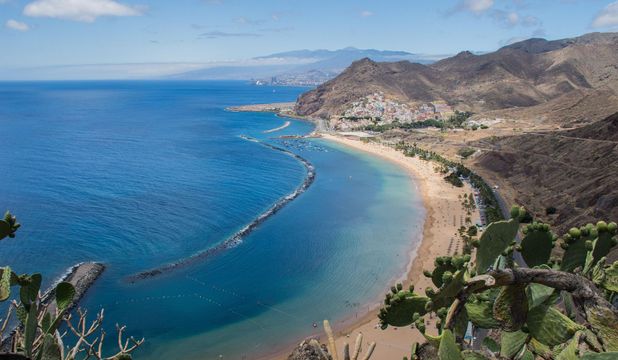Atlantic Rally for Cruisers
Duration
Team level
Activity level
Event Language

About event
Start:Las Palmas de Gran Canaria, Las Palmas, Spain
Finish:St Lucia
Atlantic Rally for Cruisers
Every November since 1986 the Atlantic Rally for Cruisers has set sail from Las Palmas, bound westward across the Atlantic to the Caribbean. Bringing together yachts from all over the world, the fleet gathers in Las Palmas Marina in the heart of the port city.
The ARC is a ‘must-do’ for many sailors and attracts over 200 boats and 1200 people every year to sail 2700 NM across the Atlantic from Gran Canaria to Saint Lucia.
The ARC is for everyone; families with children, tough racers, cruising couples, big boats, and modest boats. Regardless of your level of training and sailing experience, you can take part in this amazing event. Crossing the Atlantic together, but having their own adventures. More than just a boat race, the ARC is about friendships made ashore in the two weeks of pre-departure activities continued over the radio net at sea. It’s about arriving in Saint Lucia to be met on the dock with a rum punch and a chilled beer, knowing you have achieved something fantastic - crossing an ocean on a small sailboat.




Atlantic Rally for Cruisers
November 9, 2020 — December 19, 2020from €3,800 / 41 days / 1pers.
Events schedule
- Nov 9, 2020
ARC Office opens in Las Palmas
15/11/2020 — Last date for boat arrivals in Las Palmas

- Nov 22, 2020
Start day!
12:00 Multihulls
12:15 Racing Divisions
12:30 Cruising Divisions

- Dec 10, 2020
Majority of ARC boats arrive in Rodney Bay
- Dec 18, 2020
ARC finish line closes, 12:00 local time
- Dec 19, 2020
Prize giving ceremony
Location
Saint Lucia and Beyond There is so much to do on Saint Lucia that many yachts stay on the Island for Christmas, enjoying the warm Saint Lucian hospitality and beautiful island (and the rum punches...). many ARC boats continue their Caribbean cruising in small groups, often meeting other ARC friends in Caribbean anchorages. Every boat is welcomed to Rodney Bay Marina with rum punches, fresh fruit and chilled beer. No matter what time of day or night, the welcome party will be ready for you!
Discussion
FAQ
Can I participate in a regatta if I don’t have yachting experience?
Yes, of course. There will be an experienced skipper and team members on the yacht. They will give you a role and teach you everything you need to know to be a useful team member and feel comfortable.
Will I be able to steer a yacht?
Yes, all team members will definitely try themselves in different roles to better understand each other. Standing at the helm is an integral part of training for beginners as well as setting sails, and helping the team during moorings.
Where will I live during the regatta?
As a rule, participants in the regatta live on the yacht. The boat has everything you need for a comfortable stay: nice beds, a kitchen, a shower with toilet. If you do not want to live on a yacht, then you can arrange to stay at the hotel onshore.
What will we eat?
The crew decides altogether what kind of food they prefer to eat and makes necessary purchases. Simple dishes can be cooked, usually taking turns. Some regattas offer daily meals and intensive evening program for all crews.
Do you help with a visa?
We can make an invitation for a visa, but you need to apply for a visa by yourself.
Will I have seasick? What should I do if I have sickness?
Most people tolerate some seasickness easily. If you feel that you are starting to feel sick, it is best to get at the steering wheel or tune the sails. Get yourself busy, show your body that you don’t have time to get sick, you have to fight for victory in the race. There are also many quite effective medicines from sickness. If you start taking them in advance, then the probability of seasickness is almost zero.
How and where will I meet the crew and the captain?
Before each trip, we organize an online meeting where participants get to know each other and the captain. The captain will answer all your questions. The crew will have a group chat so you can get to know each other before the start of the regatta. Then you will meet in the marina.
What clothes do I need?
The main rule is to dress comfortably and according to the weather. Clothing: • windbreaker and pants or shorts; • shirt/jacket with UV protection (thermal underwear and fleece); • adjustable hat/cap; • gloves. We recommend to purchase a long-sleeved jacket with UV protection in order to protect yourself from the sun and strong wind. Yachting shoes should be: • light, with non-slip white outsole; • with the fixed heel; • with a tightly closed nose. During the sailing without shoes, you can fall or injure your fingers and feet on the deck. There are many protruding parts on the boat that are easy to catch. Unfortunately, even experienced sailors are not protected from unpleasant injuries when they ignore this simple rule.







No comments, be the first one!